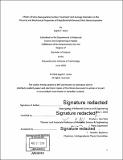Effects of silica nanoparticle surface treatment and average diameter on the physical and mechanical properties of poly(dimethylsiloxane)-silica nanocomposites
Author(s)
Guha, Ingrid F
DownloadFull printable version (4.415Mb)
Other Contributors
Massachusetts Institute of Technology. Department of Materials Science and Engineering.
Advisor
Krystyn J. Van Vliet.
Terms of use
Metadata
Show full item recordAbstract
The purpose of this thesis was to quantify the effects of silica nanoparticle surface treatments and average silica nanoparticle diameter on various macroscopic properties of poly(dimethylsiloxane)-silica nanocomposites, specifically stiffness, wettability, and permeability to organic solvents. Poly(dimethylsiloxane)-silica nancomposites were prepared with constant amounts (4.8 wt%, 1.8 vol%) of fumed silica nanoparticles with varying surface treatments (hexamethyldisilazane and octamethylcyclotetrasiloxane) and varying particle diameter (7 and 12 nm). The Young's elastic modulus, mass increase due to dodecane absorption after 10 minutes, and advancing and receding water contact angles were measured for each nanocomposite. PDMS-silica nanocomposites containing untreated silica nanoparticles were found to have a higher Young's elastic modulus than nanocomposites containing hexamethyldisilazane-treated silica nanoparticles with the same diameter. However, nanocomposites containing identically sized silica nanoparticles with and without the octamethylcyclotetrasiloxane surface treatment had the same stiffness. The average nanocomposite stiffness increased slightly as the untreated silica nanoparticle diameter decreased from 12 nm to 7 nm. Varying the surface treatment or particle diameter of the filler did not significantly affect the level of dodecane absorption or the wettability of the nanocomposite. All nanocomposites showed approximately 20-23 wt% increase from dodecane absorption after 10 minutes of dodecane immersion. All nanocomposites exhibited average advancing contact angles around 115-120° and average receding contact angles around 85-90°. Nanocomposites were imaged using optical coherence tomography to examine particle dispersion. Potential differences in particle dispersion are discussed.
Description
Thesis: S.B., Massachusetts Institute of Technology, Department of Materials Science and Engineering, 2010. Cataloged from PDF version of thesis. Includes bibliographical references (pages 35-37).
Date issued
2010Department
Massachusetts Institute of Technology. Department of Materials Science and EngineeringPublisher
Massachusetts Institute of Technology
Keywords
Materials Science and Engineering.